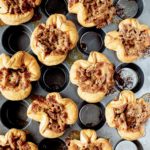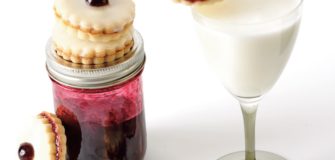Baileys Pecan Butter Tarts
Share
“Butter tarts, a Canadian classic, are the subject of much debate: to add or not to add raisins. If you are among the roughly 10% who insist they must have raisins in them, I am sorry, but I am just not a fan of raisins in desserts,” says Jenell Parsons, author of You Wanna Piece of Me?. “I also like a firm butter tart, not the sugary- syrup-running-down-your-chin kind. With my Double Butter Crust, pecans, and a nice splash of Baileys Irish cream, you will fall in love with them (even without the raisins). These are the number-one-selling item in our shops.”
Follow Jenell on IG // FB // Twitter
BAILEYS PECAN BUTTER TARTS
Ingredients
- ½ recipe Double Butter crust see below
- 1 cup (115 g) pecan pieces
- 2/3 cup (150 g) butter, at room temperature
- ¾ cup (150 g) golden sugar
- 1½ cups (375 ml) golden corn syrup
- 3 eggs
- 1/3 cup (80 ml) Baileys Irish cream
- 1 Tbsp vanilla
- 1 tsp sea salt
Double Butter Crust:
- MAKES ONE 9 – INCH DOUBLE CRUST OR TWO 9 -INCH SINGLE CRUSTS
- 1 cup (250 ml) water, ice cold
- 1 Tbsp vinegar cold
- 2 cups (454 g) butter, cold
- 4 cups (600 g) flour
- 2 Tbsp sugar
- 1 tsp salt
- Egg wash
Instructions
- Prepare the dough for a single 9-inch Double Butter Crust (see below). On a floured surface using a rolling pin, roll out the dough until it is ¼ inch thick. Cut out 12 5½ -inch circles. This is the perfect size for a standard muffin pan.
- Lightly spray a muffin pan. Gently push the dough circles into the pan; the edges will have to be pinched together at 3 or 4 points to fit. Divide the pecan pieces between the butter tart shells.
- Using a stand mixer fitted with the paddle attachment, cream the butter and the golden sugar on medium-high speed for 30 seconds to 1 minute, until the mixture is nice and smooth.
- With the mixer running on low speed, slowly add the corn syrup. Add the eggs, 1 at a time, and mix for 15 to 30 seconds between each egg. Add the Baileys, vanilla, and salt and mix until fully incorporated, 30 to 60 seconds. Do not overmix, as this can add too much air and prevent the pecans from rising to the surface while baking.
- Pour the butter mixture into the tart shells. Chill the tarts for 30 minutes in the fridge or 15 minutes in the freezer before baking. Preheat the oven to 350°F.
- Bake for 35 to 40 minutes until golden brown and bubbly. Cool for at least 30 minutes before serving. There is really nothing quite like a warm-from-the-oven fresh butter tart.
Double Butter Crust:
- MAKES ONE 9 – INCH DOUBLE CRUST (OR TWO 9 -INCH SINGLE CRUSTS)
- Start by mixing the water and vinegar together in a bowl or jug and putting it into the freezer so it’s icy cold when you need it. Cut the butter into 1-inch cubes and put them in the freezer too to keep as cold as possible while you measure the other ingredients.
Prepare the dough by hand:
- Measure the flour, sugar, and salt into a large mixing bowl and mix to fully incorporate.
- Add the cold butter to the flour mixture, and use your fingers to massage the butter into the flour, breaking it apart and coating it in flour. Continue massaging and rolling the butter between your fingers until you have a coarse mixture with pea- to almond-sized pieces of butter throughout.
- Add 3 Tbsp of the cold vinegar-water mixture. Slowly mix in the water with your hands, gently squeezing the butter and flour to help it come together. Continue adding the vinegar-water mixture just 1 Tbsp at a time, mixing it in gently with your hands. The goal is to add just enough water to get the dough to come together into a shaggy mixture —and once it gets to that point, hands off!
- See below for chilling and rolling directions.
Prepare the dough by food processor:
- In a food processor, pulse the flour, sugar, and salt until mixed. A few quick pulses should do it. Add the cold butter, a few pieces at a time, pulsing until you have a coarse mixture with pea- to almond-sized pieces of butter throughout. Do not overmix! It’s very easy to overmix, so be careful.
- Add 3 Tbsp of the cold vinegar-water mixture. Pulse a few times. Continue to add vinegar and water, 1 Tbsp at a time, pulsing a few times between each addition. The goal is to add just enough water to get the dough to come together into a shaggy mixture—and once it gets to that point, no more pulsing!
- Transfer to a floured work surface, and carefully fold any loose bits of flour and butter into the ball of dough. Folding it a few times will create layers. Next, read below for how to chill the dough.
Or prepare the dough by stand mixer:
- Using a stand mixer fitted with the paddle attachment, combine the flour, sugar, and salt on low speed. With the mixer running on low speed, add the cold butter, a few pieces at a time, mixing until you have a coarse mixture with pea- to almond-sized pieces of butter throughout. Do not overmix.
- With the mixer still running on low speed, add 3 Tbsp of the cold vinegar- water mixture. Continue to add vinegar and water, 1 Tbsp at a time, mixing for 30 seconds between each addition. The goal is to add just enough water to get the dough to come together into a shaggy mixture—and once it gets to that point, stop mixing! I find that using a stand mixer takes the most practice and that it is easy to add too much water if you are not patient.
- Once the dough just comes together, remove it from the mixing bowl, cleaning off the paddle so as not to miss out on any of the delicious buttery dough. Next, read below for how to chill the dough.
Then, chill the dough:
- Bring your dough together to form a ball, divide it in half, and wrap each piece snugly with plastic wrap. At this point the dough is quite pliable, so press it down until it forms disks about 1 inch thick. This will save both time and effort when you start rolling the dough, as it’s more difficult to roll once chilled. Place the disks in the fridge for a minimum of 30 minutes to relax the gluten in the dough, which gives you a much more tender pastry. At this point you can also freeze the dough.
Rolling the dough:
- When you are ready to start rolling, remove the dough from the fridge and unwrap it (you need 1 disk for a single-crust pie and 2 disks for a double-crust pie). If the dough is frozen, fully thaw it first (by moving it to the fridge overnight, or sitting it out on the counter for a couple of hours).
- Sprinkle your work surface and dough with flour, and use a rolling pin to start rolling out 1 of the disks. Rotate the dough 90 degrees after every few passes to work toward creating a circular shape. If the circumference of the disk is not getting larger as you roll, there’s a good chance the dough is stuck to the surface below. Carefully lift the dough and add more flour to the surface. I also often flour the top of the dough and flip it over, then continue to roll. Keep rolling out the dough until it is about ⅛ inch thick.
- Next, take your pie plate and turn it upside down in the center of the rolled dough. Use the plate as a template to cut the dough to size. Depending on the depth of the pie plate, cut out a circle of dough 1½ to 2 inches larger than the rim of the pie plate (the deeper the pie plate, the larger the circle will need to be). It is best to go larger, as you can always trim; you never want to have to stretch the dough to make it fit, as it shrinks back as it bakes.
- Remove the pie plate and sprinkle a little flour over the surface of the dough. Then gently lift and transfer the dough to the pie plate with the floured side facing down. This, along with all the butter in the dough, will help keep the pie from sticking to the pie plate, so no need to worry about greasing or flouring your pie plate. Gently press the dough into the plate.
- Dock the bottom of the dough with a fork to allow steam to escape when baking.
Next, for a single-crust pie:
- If you have more than ¼-inch overhang of dough, trim the excess with scissors, and finish the pie with a fluted edge. Tip: Create a fluted edge by pushing a little of the dough out with your thumb at the same time as pulling back the dough beside it with your index finger, squeezing and bending the dough between your fingertips to create an exaggerated fluted edge. Use the index finger on your opposite hand as a spacer between each flute for consistency.
- Use a pastry brush to brush the edges of the pie with egg wash. Make sure to get it into all the nooks and crannies to achieve a consistent perfect golden color all over. If the crust requires blind baking, do that now (see below).
- Keep chilled until you are ready to assemble the pie. Follow the individual pie recipe for next steps on filling, baking, and serving the pie. Yum!
Or, for a double-crust pie:
- Repeat steps 1 and 2 of Rolling the Dough with your second disk of dough. If you are creating a full lid for your top pie crust, try to roll the dough into an even circular shape. If you are preparing the dough for a lattice design try to roll it into more of a rectangular shape to help you cut nice even strips that will fit across the pie without stretching. Keep chilled until you are ready to assemble the pie.
- Once you have added the pie filling to the bottom crust, use a pastry brush to brush the edges of the crust with egg wash. Make sure to get it into all the nooks and crannies as this helps the top pie crust to adhere to it.
- Top with the top pie crust and secure the edges by pinching the bottom and top crusts together. Trim off any excess dough and flute the edges. Brush the whole surface with egg wash. Follow the individual pie recipe for baking and serving the pie. Double crust, double yum!
For blind baking:
- Preheat the oven to 350ºF.
- Line the inside of the prepared pie crust with parchment paper to protect the dough. Tip: Large coffee filters can also be used here instead. Add pie weights to keep the pastry in place, and so the heat of the oven doesn’t just melt the pastry into a buttery puddle in the bottom of the pie plate.
- Bake in the oven for 20 to 25 minutes. Remove from the oven, but keep the oven on. Remove the weights and parchment paper and brush the base of the pie crust with egg wash.
- For a fully blind-baked pie, return to the oven for 8 to 10 minutes; for a partially blind-baked pie, return to the oven for 3 to 5 minutes. This cooks the additional egg wash and creates a barrier between the filling and the crust to keep the crust from becoming soggy.
Notes
Excerpted from You Wanna Piece of Me? by Jenell Parsons. Copyright © 2020 The Pie Hole Holdings Corp. Photography by Janis Nicolay. Published by Appetite by Random House®, a division of Penguin Random House Canada Limited. Reproduced by arrangement with the Publisher. All rights reserved.




